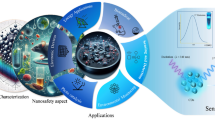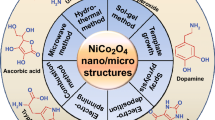Abstract
Here we report a novel electrochemical sensor based on Barium titanate / reduced graphene oxide nanocomposite (BaTiO3/rGO) for precise detection of 4-nitrophenol and Dopamine. The electrochemical characteristics of both analytes were studied using a glassy carbon electrode (GCE) modified with a BaTiO3/rGO composite film. Incorporating reduced graphene oxide (rGO) sheets with BaTiO3 nanoparticles notably improved the electrochemical reactivity of these analytes. The modified electrochemical sensor exhibits a wide linear detection range of 5 to 50 µM for 4-nitrophenol, with a remarkably low detection limit of 0.44 µM. Similarly, dopamine detection demonstrates consistent linearity spanning from 2.5 to 50 µM, with an impressive detection limit of 0.08 µM. Real-world assessments using tap water and human urine samples underscore the exceptional recovery results, highlighting its practical utility.
Graphical abstract















Similar content being viewed by others
Data availability
Data sharing is not applicable to this article as no datasets were generated analysed during the current study.
References
Löser C, Oubelli MA, Hertel T (1998) Growth kinetics of the 4-nitrophenol degrading strain Pseudomonas putida PNP1. Acta Biotechnol 18:29–41
Sharma K, Ali M, Singh R, Majhi S, Sharma S, Tripathi CSP, Guin D (2022) Silver nanoparticles decorated on graphene oxide modified polyester fabric: Catalytic reduction of 4-nitrophenol, organic dyes and SERS application. J Phys Chem Solids 165:110640
Jackowska K, Krysinski P (2013) New trends in the electrochemical sensing of dopamine. Anal Bioanal Chem 405:3753–3771
Khan AF, Brownson DA, Randviir EP, Smith GC (2016) Banks, 2D hexagonal boron nitride (2D-hBN) explored for the electrochemical sensing of dopamine. Anal Chem 88:9729–9737
Sajid M, Baig N, Alhooshani K (2019) Chemically modified electrodes for electrochemical detection of dopamine: challenges and opportunities. TRAC Trends Anal Chem 118:368–385
Yang Z, Liu X, Zheng X, Zheng J (2018) Synthesis of Au@ pt nanoflowers supported on graphene oxide for enhanced electrochemical sensing of dopamine. J Electroanal Chem 817:48–54
Orzari LO, de Freitas RC, de Araujo Andreotti IA, Gatti A, Janegitz BC (2019) A novel disposable self-adhesive inked paper device for electrochemical sensing of dopamine and serotonin neurotransmitters and biosensing of glucose. Biosens Bioelectron 138:111310
Ma Y, Zhao M, Cai B, Wang W, Ye Z, Huang J (2014) 3D graphene network@ WO 3 nanowire composites: a multifunctional colorimetric and electrochemical biosensing platform. Chem Commun 50:11135–11138
Sanghavi BJ, Wolfbeis OS, Hirsch T, Swami NS (2015) Nanomaterial-based electrochemical sensing of neurological Drugs and neurotransmitters. Microchim Acta 182:1–41
George JM, Antony A, Mathew B (2018) Metal oxide nanoparticles in electrochemical sensing and biosensing: a review. Microchim Acta 185:1–26
Mohan JM, Amreen K, Javed A, Dubey SK, Goel S (2020) Highly selective electrochemical sensing of dopamine, xanthine, ascorbic acid and uric acid using a carbon fiber paper. IEEE Sens J 20:11707–11712
Eddin FBK, Fen YW (2020) Recent advances in electrochemical and optical sensing of dopamine. Sensors 20:1039
Adhikari A, De S, Rana D, Nath J, Ghosh D, Dutta K, Chakraborty S, Chattopadhyay S, Chakraborty M, Chattopadhyay D (2020) Selective sensing of dopamine by sodium cholate tailored polypyrrole-silver nanocomposite. Synth Met 260:116296
Li Y, Shen Y, Zhang Y, Zeng T, Wan Q, Lai G, Yang N (2021) A UiO-66-NH2/carbon nanotube nanocomposite for simultaneous sensing of dopamine and acetaminophen. Anal Chim Acta 1158:338419
Suhito IR, Angeline N, Kim T-H (2019) Nanomaterial-modified hybrid platforms for precise electrochemical detection of dopamine. Biochip J 13:20–29
Zhu T, Yang Y, Gong X (2020) Recent advancements and challenges for low-toxicity perovskite materials. ACS Appl Mater Interfaces 12:26776–26811
Huang Y, Liu J, Deng Y, Qian Y, Jia X, Ma M, Yang C, Liu K, Wang Z, Qu S (2020) The application of perovskite materials in solar water splitting. J Semicond 41:011701
Moniruddin M, Ilyassov B, Zhao X, Smith E, Serikov T, Ibrayev N, Asmatulu R, Nuraje N (2018) Recent progress on perovskite materials in photovoltaic and water splitting applications. Mater Today Energy 7:246–259
Wang M, Wang W, Ma B, Shen W, Liu L, Cao K, Chen S, Huang W (2021) Lead-free perovskite materials for solar cells. Nano-Micro Lett 13:1–36
Fu W, Ricciardulli AG, Akkerman QA, John RA, Tavakoli MM, Essig S, Kovalenko MV, Saliba M (2022) Stability of perovskite materials and devices. Mater Today 1:211
Fang T, Zhang F, Yuan S, Zeng H, Song J (2019) Recent advances and prospects toward blue perovskite materials and light-emitting diodes. InfoMat 1:211–233
Suematsu K, Arimura M, Uchiyama N, Saita S (2018) Transparent BaTiO3/PMMA nanocomposite films for display technologies: facile surface modification approach for BaTiO3 nanoparticles. ACS Appl Nano Mater 1:2430–2437
Moreira M, Mambrini G, Volanti D, Leite E, Orlandi M, Pizani P, Mastelaro V, Paiva-Santos C, Longo E, Varela JA (2008) Hydrothermal microwave: a new route to obtain photoluminescent crystalline BaTiO3 nanoparticles. Chem Mater 20:5381–5387
Brisebois P, Siaj M (2020) Harvesting graphene oxide–years 1859 to 2019: a review of its structure, synthesis, properties and exfoliation. J Mater Chem C 8:1517–1547
Tarcan R, Todor-Boer O, Petrovai I, Leordean C, Astilean S, Botiz I (2020) Reduced graphene oxide today. J Mater Chem C 8:1198–1224
Yu W, Sisi L, Haiyan Y, Jie L (2020) Progress in the functional modification of graphene/graphene oxide: a review. RSC Adv 10:15328–15345
Zhang P, Li Z, Zhang S, Shao G (2018) Recent advances in effective reduction of graphene oxide for highly improved performance toward electrochemical energy storage. Energy Environ Mater 1:5–12
Alam AU, Deen MJ (2020) Bisphenol A electrochemical sensor using graphene oxide and β-cyclodextrin-functionalized multi-walled carbon nanotubes. Anal Chem 92:5532–5539
Choi S, Kim C, Suh JM, Jang HW (2019) Reduced graphene oxide-based materials for electrochemical energy conversion reactions. Carbon Energy 1:85–108
Marcano DC, Kosynkin DV, Berlin JM, Sinitskii A, Sun Z, Slesarev A, Alemany LB, Lu W, Tour JM (2010) Improved synthesis of graphene oxide. ACS Nano 4:4806–4814
Yang X, Li D, Ren Z, Zeng R, Gong S, Zhou D, Tian H, Li J, Xu G, Shen ZJ (2016) Colossal dielectric performance of pure barium titanate ceramics consolidated by spark plasma sintering. RSC Adv 6:75422–75429
Zhang S, Zhang B, Li S, Li X, Huang Z (2016) SPR enhanced photocatalytic properties of Au-dispersed amorphous BaTiO3 nanocomposite thin films. J Alloys Compd 654:112–119
Johra FT, Jung W-G (2015) Hydrothermally reduced graphene oxide as a supercapacitor. Appl Surf Sci 357:1911–1914
Kutluay A, Aslanoglu M (2013) Modification of electrodes using conductive porous layers to confer selectivity for the voltammetric detection of Paracetamol in the presence of ascorbic acid, dopamine and uric acid. Sens Actuators B 185:398–404
Madhu R, Dinesh B, Chen S-M, Saraswathi R, Mani V (2015) An electrochemical synthesis strategy for composite based ZnO microspheres–Au nanoparticles on reduced graphene oxide for the sensitive detection of hydrazine in water samples. RSC Adv 5:54379–54386
Supraja P, Singh V, Vanjari SRK, Govind Singh S (2020) Electrospun CNT embedded ZnO nanofiber based biosensor for electrochemical detection of atrazine: a step closure to single molecule detection. Microsyst Nanoeng 6:1–10
Tang Y, Huang R, Liu C, Yang S, Lu Z, Luo S (2013) Electrochemical detection of 4-nitrophenol based on a glassy carbon electrode modified with a reduced graphene oxide/Au nanoparticle composite. Anal Methods 5:5508–5514
Wang J, Yang B, Zhong J, Yan B, Zhang K, Zhai C, Shiraishi Y, Du Y, Yang P (2017) Dopamine and uric acid electrochemical sensor based on a glassy carbon electrode modified with cubic pd and reduced graphene oxide nanocomposite. J Colloid Interface Sci 497:172–180
Hareesha N, Manjunatha J (2020) Fast and enhanced electrochemical sensing of dopamine at cost-effective poly (DL-phenylalanine) based graphite electrode. J Electroanal Chem 878:114533
Zhang H, Liu S (2020) Electrochemical sensors based on nitrogen-doped reduced graphene oxide for the simultaneous detection of ascorbic acid, dopamine and uric acid. J Alloys Compd 842:155873
Lupu S, Lete C, Marin M, Totir N, Balaure PC (2009) Electrochemical sensors based on platinum electrodes modified with hybrid inorganic–organic coatings for determination of 4-nitrophenol and dopamine. Electrochim Acta 54:1932–1938
Guan Q, Guo H, Xue R, Wang M, Zhao X, Fan T, Yang W, Xu M, Yang W (2021) Electrochemical sensor based on covalent organic frameworks-MWCNT-NH2/AuNPs for simultaneous detection of dopamine and uric acid. J Electroanal Chem 880:114932
Sajeevan B, Gopika M, Murali AS, Saraswathyamma B (2023) An electrochemical sensor based on a pencil graphite electrode modified with poly-riboflavin for 4-nitrophenol quantification. Mater Chem Phys 301:127568
Dhiman P, Sharma S, Kumar A, Shekh M, Sharma G, Naushad M (2020) Rapid visible and solar photocatalytic cr (VI) reduction and electrochemical sensing of dopamine using solution combustion synthesized ZnO–Fe2O3 nano heterojunctions: mechanism elucidation. Ceram Int 46:12255–12268
Ali M, Sharma S, Singh R, Sharma K, Majhi S, Guin D, Tripathi CSP (2022) Barium Titanate Nanocubes as a Dual Electrochemical Sensor for Detection of Dopamine and Acetaminophen. J Electrochem Soc 169:067512
Abdel-Aziz AM, Hassan HH, Badr IH (2022) Activated glassy carbon electrode as an electrochemical sensing platform for the determination of 4-nitrophenol and dopamine in real samples. ACS Omega 7:34127–34135
Acknowledgements
MA thanks CSIR-India, for CSIR-SRF(NET) fellowship, file No. 09/013(0921)-2019-EMR-I. CSPT thanks Science and Engineering Research Board (SERB, India) for the financial support through grant no. ECR/2016/000298. DG and CSPT thank Banaras Hindu University, Varanasi for providing seed grant under IoE scheme (Dev. Scheme No. 6031). The authors also acknowledge help from the Department of Physics, and Department of Chemistry BHU for the use of instruments.
Funding
There is no availability of funding.
Author information
Authors and Affiliations
Contributions
All authors contributed to the discussions and editing of the manuscript. All authors read and approved the final manuscript.
Corresponding authors
Ethics declarations
Conflict of interest
The authors declare that they have no competing interests.
Additional information
Publisher’s Note
Springer Nature remains neutral with regard to jurisdictional claims in published maps and institutional affiliations.
Rights and permissions
Springer Nature or its licensor (e.g. a society or other partner) holds exclusive rights to this article under a publishing agreement with the author(s) or other rightsholder(s); author self-archiving of the accepted manuscript version of this article is solely governed by the terms of such publishing agreement and applicable law.
About this article
Cite this article
Ali, M., Sharma, K., Guin, D. et al. BaTiO3/rGO nanocomposite modified glassy carbon electrode for electrochemical sensing of 4‑nitrophenol and dopamine in real samples. J Appl Electrochem 54, 1349–1363 (2024). https://doi.org/10.1007/s10800-023-02036-1
Received:
Accepted:
Published:
Issue Date:
DOI: https://doi.org/10.1007/s10800-023-02036-1




